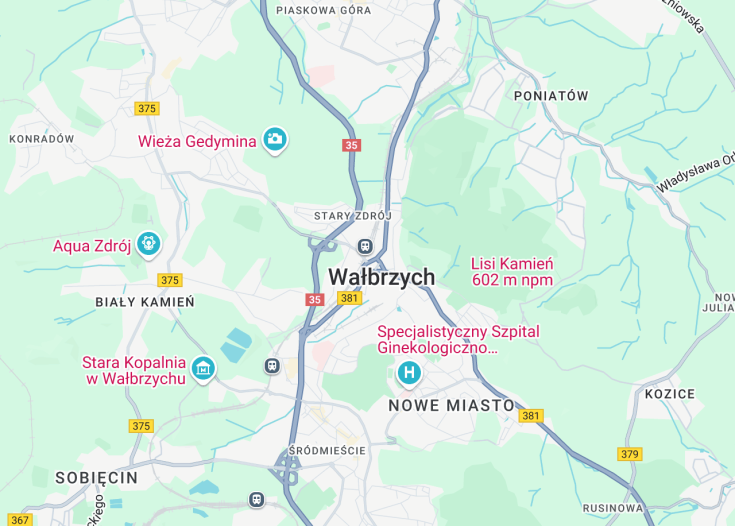Nestled in the Lower Silesian Voivodeship of Poland, Wałbrzych is a captivating city steeped in rich history and surrounded by lush mountains. Renowned for its well-preserved 16th-century Książ Castle and extensive underground tunnels, Wałbrzych offers a unique blend of cultural heritage and natural beauty. The city’s intriguing past as a coal mining center adds a distinctive industrial charm, making it a fascinating destination for history buffs and adventure seekers alike.
Before visiting Wałbrzych, ensure you plan a guided tour through the Książ Castle’s underground tunnels, which offer a glimpse into mysterious historical narratives and architectural marvels.
Consider visiting Wałbrzych in late spring or early autumn to enjoy the scenic landscapes and outdoor activities around the city at their finest, with more comfortable weather conditions.
Top things to do & see in Wałbrzych
Select the following sights and activities to discover best tickets and tours available in Wałbrzych.
Wałbrzych: A Hidden Gem in the Heart of Lower Silesia
| Country | Poland |
| Time in Wałbrzych | GMT+1 |
| Language spoken | Polish |
| Population | 116,197 (as per World Population Review) |
| Currency | Polish Złoty (PLN, zł) |
| Airports |
|
Located in southwestern Poland, Wałbrzych is a city steeped in history and intrigue. Formerly known as Waldenburg, the city has a rich industrial heritage, primarily the coal mining industry, which significantly influenced its development and culture. Today, Wałbrzych and its surroundings are known for beautifully preserved historic castles, including the Książ Castle, one of the largest in Poland. It is also rumored to be the site of the mysterious Nazi train laden with treasure that disappeared during World War II, adding a layer of mystique to the region.
Where is Wałbrzych?
Wałbrzych is situated in Lower Silesia, southwest Poland, near the Czech and German borders, offering a picturesque landscape of mountains and forests.
Distances:
| Route | Distance by car | Time by car |
|---|---|---|
| Warsaw to Wałbrzych | 371 mi | 5 hours 40 min |
| Krakow to Wałbrzych | 189 mi | 3 hours 40 min |
| Wrocław to Wałbrzych | 44 mi | 1 hour 10 min |
What is Wałbrzych famous for?
Wałbrzych is famous for its historical significance in the mining industry, numerous well-preserved castles including Książ Castle, and the fascinating legends surrounding hidden Nazi treasures.
History
Wałbrzych, a city rich in history and culture in the Lower Silesian Voivodeship of Poland, has evolved from ancient settlements, through significant industrial development, to become a notable modern city. The history of Wałbrzych can be dissected into different epochs, each marked by significant events and transformations.
Pre-12th Century: Early Settlements
The area around modern-day Wałbrzych has been inhabited since the Stone Age, with archaeological finds suggesting the presence of early human activity. By the Middle Ages, Slavic tribes settled in the region, engaging in agriculture and crafting.
12th Century – 16th Century: Medieval Growth
Wałbrzych’s recorded history began in the 12th century when it was a small settlement in the Duchy of Silesia, part of the Kingdom of Poland. The discovery of coal in the 16th century marked a pivotal turn, leading to the town’s burgeoning growth as it started to exploit its mineral resources.
17th Century – 19th Century: Industrial Expansion
The industrial revolution of the 19th century fueled Wałbrzych’s development into a major coal mining center. This period saw substantial economic growth, with the emergence of numerous factories and an increase in population due to the demand for labor.
20th Century: War and Reformation
Wałbrzych experienced significant hardships during both World Wars, particularly the second, with many historical buildings damaged. After World War II, the region was incorporated into Poland, and the city underwent a process of rebuilding. The decline of the coal industry in the late 20th century led to economic challenges, prompting a shift towards service industries and cultural development.
21st Century: Modernization and Revival
In recent years, Wałbrzych has focused on modernizing infrastructure and revitalizing its cultural heritage. It has become a center for arts, education, and tourism, building on its rich history and unique landscape.
Visit Wałbrzych
What to see and do in Wałbrzych, Poland
Wałbrzych offers a plethora of attractions and activities for visitors:s
- Explore Książ Castle, the third largest castle in Poland, nestled in the lush Wałbrzych Hills.
- Visit the Old Mine Science and Art Centre, a former coal mine turned into a cultural venue.
- Stroll through the exquisite Palm House, a greenhouse that houses a diverse collection of exotic plants.
- Hike the trails of the Wałbrzych Mountains, offering scenic views and rich biodiversity.
Annual Events in Wałbrzych
Wałbrzych hosts several cultural and historical events throughout the year:
- The Wałbrzych Days in June celebrate the city’s heritage with concerts, exhibitions, and street fairs.
- In September, the Książ Castle Festival features medieval games, arts, and crafts, creating a lively historical atmosphere.
Best time to visit Wałbrzych
The best times to visit Wałbrzych are late spring and early autumn when the weather is mild and the natural surroundings are at their most vibrant.
Is Wałbrzych worth visiting?
Wałbrzych is definitely worth visiting for its rich historical tapestry, cultural depth, and the stunning natural beauty of its surroundings. From exploring grandiose castles and historical mines to enjoying the serene landscapes, Wałbrzych offers a compelling blend of adventure and tranquility that caters to diverse interests.










